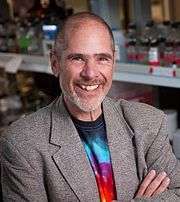Douglas R. Green
Douglas Green (born 1955), is an American biologist. He holds the Peter C. Doherty Endowed Chair of Immunology in St. Jude Children's Research Hospital. His research has focused on the process of active cell death and cell survival, extending from the role of cell death in cancer regulation and immune responses in the whole organism to the molecular events directing the death of the cell. Green was editor in chief of the journal Oncogene from 2009-2016, is a Deputy Editor of the journal "Science Advances" and the author of the book Cell Death, Means To An End.
Douglas R. Green | |
|---|---|
 | |
| Born | Douglas R Green February 1955 (age 65) United States |
| Nationality | United States |
| Known for | Apoptosis research |
| Scientific career | |
| Fields | Cell Death, Cancer Biology, Immunology |
| Institutions | St. Jude Children's Research Hospital |
| Thesis | Contrasuppression: An Immunoregulatory T Cell Activity (1981) |
| Doctoral advisor | Richard K. Gershon |
| Website | www |
Education
Green attended high school in Ashland, MA. He graduated magna cum laude from the Yale University with a Bachelor of Science in Biology and Distinction in Biology in 1977. After training at MIT during 1977 and 1978, he graduated in 1981 with a PhD from Yale University, where he studied immunology with Richard K. Gershon.
Green joined the faculty at the University of Alberta in Edmonton in 1985.[1]. In 1990, Green moved to the La Jolla Institute for Allergy and Immunology, where he became Head of the Division of Cellular Immunology.[1] In 2005, he moved to St. Jude Children's Research Hospital to become the Peter C. Doherty Endowed Chair of the Department of Immunology.[1][2]
Research
After many studies on immunological tolerance, Green's work on cell death began with his discovery of activation-induced apoptosis in T lymphocytes,[3][4] the role of c-Myc in this process[5] and the finding that Bcl-2 cooperates with Myc in oncogenesis by blocking apoptosis.[6] More recently, he discovered the process of LC3-associated phagocytosis, which links the autophagy pathway to phagosome maturation.[7] Other areas of interest include regulated necrosis,[8] metabolic reprogramming in T lymphocytes,[9] and the function of the tumor suppressor, p53.[10] As of 2014 he had published many chapters and books and over 500 papers, making him one of the world's most cited molecular biologists.[11] He is listed in:
- ISI "highly cited" (Immunology 2003)
- ISI "highly cited" (Molecular Biology/Genetics 2014)
Recognition
Green has received many awards, among these the E.J. Boell Award (Biology) (Yale, 1977), the J.S. Nicholas Award (Zoology) (Yale, 1981), Alberta Heritage Scholar (AHFMR 1985-1990), the Outstanding Teacher Award (Alberta, 1990), Ashland Public School System Hall of Fame[12] (Ashland, MA 1998), MERIT Award, NIGMS (2002), the International Cell Death Society Prize[13] (2009), Einstein Professorship (China, 2011). He is an Honorary Fellow of Trinity College, Dublin (2010)[14] and Dottore Honoris Causa of Rome University Tor Vergata (2016)[15] Green was elected to the Royal Society of Canada in 2018 and the United States National Academy of Sciences in 2020 [16].
References
- "Major Symposium Speaker: Douglas Green". International Congress of Immunology. Retrieved 11 July 2019.
- "Douglas R. Green, PhD". St Jude Children's Research Hospital. Retrieved 11 July 2019.
- Shi, Y. F.; Sahai, B. M.; Green, D. R. (1989). "Cyclosporin a inhibits activation-induced cell death in T-cell hybridomas and thymocytes". Nature. 339 (6226): 625–6. doi:10.1038/339625a0. PMID 2786609.
- Shi, Y. F.; Szalay, M. G.; Paskar, L; Sahai, B. M.; Boyer, M; Singh, B; Green, D. R. (1990). "Activation-induced cell death in T cell hybridomas is due to apoptosis. Morphologic aspects and DNA fragmentation". Journal of Immunology. 144 (9): 3326–33. PMID 1691753.
- Shi, Y; Glynn, J. M.; Guilbert, L. J.; Cotter, T. G.; Bissonnette, R. P.; Green, D. R. (1992). "Role for c-myc in activation-induced apoptotic cell death in T cell hybridomas". Science. 257 (5067): 212–4. doi:10.1126/science.1378649. PMID 1378649.
- Bissonnette, R. P.; Echeverri, F; Mahboubi, A; Green, D. R. (1992). "Apoptotic cell death induced by c-myc is inhibited by bcl-2". Nature. 359 (6395): 552–4. doi:10.1038/359552a0. PMID 1406975.
- Sanjuan, M. A.; Dillon, C. P.; Tait, S. W.; Moshiach, S; Dorsey, F; Connell, S; Komatsu, M; Tanaka, K; Cleveland, J. L.; Withoff, S; Green, D. R. (2007). "Toll-like receptor signalling in macrophages links the autophagy pathway to phagocytosis". Nature. 450 (7173): 1253–7. doi:10.1038/nature06421. PMID 18097414.
- Dillon, C. P.; Weinlich, R; Rodriguez, D. A.; Cripps, J. G.; Quarato, G; Gurung, P; Verbist, K. C.; Brewer, T. L.; Llambi, F; Gong, Y. N.; Janke, L. J.; Kelliher, M. A.; Kanneganti, T. D.; Green, D. R. (2014). "RIPK1 blocks early postnatal lethality mediated by caspase-8 and RIPK3". Cell. 157 (5): 1189–202. doi:10.1016/j.cell.2014.04.018. PMC 4068710. PMID 24813850.
- Wang, R; Dillon, C. P.; Shi, L. Z.; Milasta, S; Carter, R; Finkelstein, D; McCormick, L. L.; Fitzgerald, P; Chi, H; Munger, J; Green, D. R. (2011). "The transcription factor Myc controls metabolic reprogramming upon T lymphocyte activation". Immunity. 35 (6): 871–82. doi:10.1016/j.immuni.2011.09.021. PMC 3248798. PMID 22195744.
- Chipuk, J. E.; Kuwana, T; Bouchier-Hayes, L; Droin, N. M.; Newmeyer, D. D.; Schuler, M; Green, D. R. (2004). "Direct activation of Bax by p53 mediates mitochondrial membrane permeabilization and apoptosis". Science. 303 (5660): 1010–4. doi:10.1126/science.1092734. PMID 14963330. S2CID 9793389.
- "ISI - highlycited.com". Retrieved 2015-02-06.
- Hall of Fame
- International Cell Death Society Prize Archived February 25, 2015, at the Wayback Machine
- Trinity College Fellows Scholars 2010
- Dottorato Honoris Causa in 'Biochimica e Biologia Molecolare' a Douglas R. Green
- News from the National Academy of Sciences